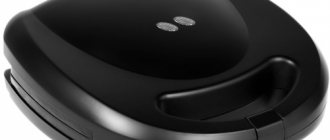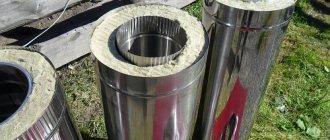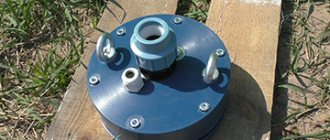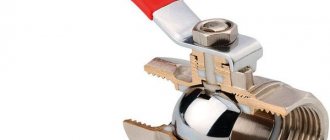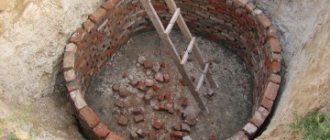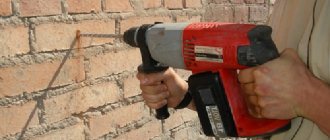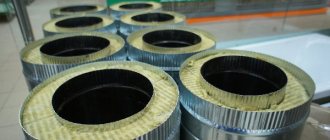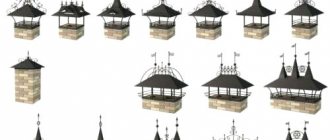Weak spots
Car tires are one of the popular material options for wastewater treatment plants. However, septic tanks made from them are small in volume, and with a water consumption rate per person of 200 liters, it is extremely difficult to make a treatment system of such a size that it can dispose of all the wastewater. But you can use tires to build a septic tank with your own hands for a garage or any other room where little water is used.
Tire treatment facilities have another big drawback. Unlike concrete and fiberglass counterparts, they are not strong enough to withstand soil pressure. And if such a structure is crushed by the soil, then everything that was inside it is squeezed up and ends up on the surface of the earth.
A good alternative to a tire treatment station is one of the already mentioned factory-made stations. In addition, you can build a country sewer yourself from a different material. Using concrete or concrete rings, you can build a reliable sewer system at a very economical price.
For those who are sure that a tire septic tank is right for them, we offer instructions for its construction.
The process of making a septic tank with your own hands
Any construction will require permission from local authorities. This will apply to everything that has a laying depth of more than 5 meters.
Please note that if there are no cables or other objects on the site, then a permit can be issued at the city or village government.
Next, you can begin installing a septic tank on your site.
The sequence of actions is as follows:
Choose a place to make a septic tank.- A trench should be dug from the outer wall of the house to the place where the septic tank will be located. Its bottom must be located lower than the soil freezing level in your region, by about 0.2-0.3 meters.
- Select a type of septic tank design.
- Dig a pit. The pit must be about 0.2-0.3 meters larger in diameter than the tires.
- Next, the bottom of the pit should be filled with drainage, so first lay a layer of sand with a thickness of 0.4 meters, and on top pour granite crushed stone of the middle fraction, also about 0.4 meters thick.
- Used car tires should be stacked on top of each other, up to 10 pieces.
- Holes should be cut between the top tire and the one next to it so that the drain pipe fits tightly.
- The space between the walls of the pit and the tires should be filled with sprinkling - it is best to use expanded clay for these purposes.
- Install a plastic sewer manhole with a lid on top, sprinkle everything with fine soil and cover with turf with green grass.
But where to install a septic tank from car tires with your own hands?
What would be a good place to place
The wastewater storage tank should not be located near the source of water supply - well, well, deep-well pump. The infection from the septic tank will begin to seep into the groundwater, and will then contaminate the drinking source with its pathogenic bacteria. In addition, it cannot be installed very close to the foundation of a house, barn or bathhouse. The soil will begin to settle, the foundation will sink and this will lead to the structure collapsing.
Also, do not place the pit too far from the house, as this can lead to a large increase in the cost of the system. For the entire length of the sewer pipe, you will need to install at least two inspection wells, which will be equipped with hatches. Laying an overly long pipeline from the septic tank to the house is fraught with the formation of blockages. The optimal length of the drain pipe is considered to be from 5 to 10 meters, and the slope should be 50 cm for every 10 meters of pipeline length.
It is interesting that such a position will make it possible for any liquids to flow by gravity from the riser of the home system into the septic tank pit, which will be located in the yard.
The diameter of the pipe, which must be made of plastic, should not be less than 0.5 meters. When connecting a drain pipe to a home sewer, do not lay it under the foundation of the house. The best way to do this is to use a hammer drill, crowbar, or jackhammer to punch out a special niche in the upper part of the foundation into which you can insert a pipeline and seal the cracks with cement mortar.
There are three variations of septic tanks with different design features:
- With a filtration system.
- With absorption well and settling tank.
- With filtration system and drainage pipe.
We suggest choosing a budget option - with a filtration system.
Advantages and disadvantages of the design
Let's look at the benefits of creating a septic tank on a private dacha plot, which will be made from old tires.
Benefit:
- Availability of building material in the form of old automobile rubber.
- Easy to install.
- Cost savings, since one reinforced concrete ring would cost 5,000 rubles, and at least 3 of them were required.
- It is possible to place the septic tank anywhere in the yard.
The disadvantages are the following: due to the fact that the body is not monolithic, has a small mass, and has a weak level of sealing, the service life of a rubber pit is much shorter than a septic tank made of concrete or plastic rings. Ground movements often move tires that are stacked on top of each other.
How to make a drain hole out of wheels
Now you know how to make a septic tank from tires with your own hands, but not how to make a drainage pit. A cesspool is a sealed tank from which wastewater must be pumped out on a regular basis.
Please note that a structure made from waste tires differs from a septic tank in that during construction it must have walls that are completely sealed, and a drip bottom must be installed.
First, you should ensure complete isolation of the drain liquid in the pit from the adjacent soil. When released into the soil around the pit, pathogenic bacteria can begin to seep into the water intake structures.
Types of structures:
- Columns.
- Wells.
- Wells.
If you contaminate a source of drinking water, the viruses in it can cause serious illnesses and sometimes epidemics. For this reason, it is worth protecting residents from exposure to bacteria that live in the waste products of animals and people. A cesspool is required to drain liquid waste, including from toilets and sinks.
A cesspool with high-quality waterproofing makes it possible to:
- To be a storage facility for liquid waste until it is necessary to pump it out using a sewer truck.
- Reliably protect the soil and water in the ground from the ingress of dangerous microorganisms that can be pathogenic and found in waste dirty water.
- Prevent the spread of unpleasant odors.
- Maintain the attractiveness of the landscape around the house.
The following is a step-by-step process for creating a drain pit:
- In order to equip a cesspool, you should lay an inclined sewer pipe, which will be laid in the same way as for a septic tank structure, in a trench to the place where the cesspool will be.
- Dig a pit that will be approximately 0.2-0.3 meters wider than the diameter of the tires used.
- The bottom of the pit should be covered with a layer of sand, the thickness of which will be 0.2 meters, and on top everything should be covered with granite crushed stone of a small fraction.
- Install wooden or panel formwork and fill everything with liquid concrete. The thickness of the concrete should be 0.2 meters.
When the concrete hardens, place used car tires on top of each other at the bottom (there should be no more than 10 of them). Be sure to place the wheels one at a time. Before laying the bottom tire, apply a little bitumen mastic or modified bitumen with a thickness of 3 cm to the plane of contact with the concrete.- Similar layers will need to be applied to each gap between the tires all the way to the top. This will make it possible to create a high-quality and sealed tank. After the primer solution has dried, the bitumen should be heated and applied to the outer walls of the tire using a wide brush. Glue fiberglass on top, which should be covered again with liquid bitumen. This coating should only be done on top of a concrete floor.
- After all the wheels have been laid and processed, the space between the soil walls and the pit tires should be filled with clay. You can dilute it with water and pour it into the free space. You will get a kind of clay castle.
- Cover the cesspool with slabs and beams, leaving only holes for exhaust.
- Install a plastic sewer manhole with a cover.
- Conceal the location of the hole with turf and grass.
To make the process clearer, we suggest you watch the video tutorial.
When is it prohibited to build septic tanks?
There are a number of cases when the construction of any model of soil drainage is impossible. The reason may be that your site:
- located in the sanitary protection zone of the reservoir;
- built on non-filtering soil;
- located in a rocky area or in the middle of a slope, where waterlogged soil can lead to landslides;
- stands on ground with a high groundwater level, where septic tank filter wells cannot be installed;
- has such a configuration that it is not possible to install a treatment facility on it in accordance with sanitary, construction or technological standards.
Where on the property should the septic tank be located?
In order not to encounter claims from the sanitary and epidemiological station, you should think in advance about the location of the future treatment plant in accordance with SanPin standards.
The septic tank should be no closer than 4 meters from the house.
From its bottom to the aquifer of soil and the water intake well there must be at least 50 meters if the filtering layer of soil is connected to the aquifer, and at least 20 meters if there is no connection between the layers.
The septic tank must be separated by at least 30 meters from any body of standing water.
Also, before the future treatment plant, you should count 3 meters from each tree and 1 meter from each shrub on your site, so that their roots do not lead to the destruction of the structure.
Optimal volume of septic tank
As already mentioned at the beginning of the article, the volume of treatment facilities is calculated based on the fact that water consumption per person per day is 200 liters. The period of filtration of wastewater in a sewerage structure is three days. Therefore, if 1 person permanently lives in a house, a treatment station with a volume of 600 liters will be enough for him, but for a family of 2 or 3 people, larger facilities will be needed - from 1200 to 1800 liters.
The volume of a tire septic tank is calculated using the following formula:
V = π r2h,
where V denotes the volume of the septic tank, π is a constant (3.14), r2 is the radius of the tire, h is its height.
Thus, we see that when building a tire treatment plant, a lot depends on what kind of tires you choose.
Selection of tires for septic tanks and other materials
It is desirable that they be of large diameter and maximum width - from heavy vehicles - there are enough of them at truck tire shops. The quantity depends on the width of the tires. It is desirable that their total height be 2 - 2.5 m. For the upper part you will need 2 - 3 slopes of smaller diameter, but harder.
If you plan to make a septic tank with overflow into a second (third) well, then increase the number of tires according to the task.
You will also need about 1 cube of coarse crushed stone, half a cube of fatty clay, sand, a steel pipe with a diameter of 100 - 120 mm, and a sewer manhole assembly. It wouldn’t hurt to have scraps of a half-inch polypropylene pipe 15–20 cm long in quantities of 3 or 4 pieces. at each joint between the slopes located below the drain pipe.
If you are planning a septic tank with an overflow, then you will need a reinforced concrete paving slab with dimensions larger than the internal diameter of the top tire, which will need to close the receiving well, and a piece of geomembrane (or a material replacing it) with dimensions larger than the diameter of the top tires by approximately 100 mm.
To cut tires, you may need a powerful sharp knife, a grinder with a circle for metal 125 - 150 mm and (or) a jigsaw with a file for the same material, a screwdriver, and self-tapping screws.
Pit for a septic tank made from tires
It is extremely important for any treatment system to avoid close contact with groundwater. Therefore, the very bottom of the pit where the filter well will be located should be 1-1.5 m above the groundwater level. In other words, the groundwater level in the area of the filter well should not rise above 3 meters from the surface.
The size of the pit is calculated based on the diameter of the tires, to which you need to add 20-30 cm on each side to leave room for backfilling.
The bottom of the pit is leveled and covered with a layer of sand and water for shrinkage, 10-15 cm thick.
If the septic tank is planned to have several sections, each of them will require its own pit. Between them you need to dig a trench into which the overflow pipe will lie.
The procedure for performing work on installing a septic tank
First of all, we suggest watching a video that shows the sequence of work.
Of the large number of similar video materials, it - in our opinion - contains the smallest number of errors made when installing such septic tanks, but still, it is not without them. From the description you will see what they are. So:
1. Prepare large diameter slopes for installation. To do this, we cut off parts of the beads on all of them, except for the top one, on which smaller-diameter tires will be placed, and the bottom one, which is installed on the drainage layer. We leave one side of them uncut.
This will not only slightly increase the useful volume of the pit, but will also prevent sediment from accumulating in the recesses of the slopes.
2. We lay the tire in the intended location of the septic tank and mark the hole with an indentation of 10 - 15 cm from its edge. They will be needed to install a drainage layer around the column of tires. If you plan to overflow, step back at least a meter from the main well and do the same.
3. The depth of the pit should be at least 2, but preferably up to 3 m, if the level of upper groundwater allows. The total height of the tires (with spacers made of tubes) + drainage bedding made of crushed stone 200 - 300 mm will partially correct it. The head of the sewer hatch installed on the top tire should protrude 3–10 cm above the ground surface.
4. If you decide to install an additional drainage pipe, then drill a hole for it with a drill with a diameter 8–10 cm larger than the diameter of this pipe.
It would be a good idea to lower it down to a meter into the ground, and leave the upper edge at a height not reaching the level of the drain pipe by 20 - 30 cm. This will enhance the drainage of the pit during sudden short-term fillings. In the part of the pipe entering the ground and on top - 20 - 30 cm from the edge, it is necessary to drill perforation holes. The distance between the pipe and the recess must be carefully compacted with crushed stone of a larger fraction than the perforation holes in it.
5. At the bottom of the pit, lay a drainage layer of coarse crushed stone (200–300 mm) on a 3–5 cm sand cushion.
We do not recommend using broken bricks and similar materials - they will get wet and collapse, which will lead to subsidence of the structure and poor drainage.
6. Lay the bottom slope with the uncut side down. We screw the pipe cuttings onto it with self-tapping screws and, before continuing to lay the tires, carefully compact the gap between it and the edge of the pit with crushed stone. Its fraction must be larger than the diameter of the installed tubes. We continue laying the remaining slopes and adding crushed stone to a level just below (1 slope) the drain pipe.
Instead of tubes, you can make slits in the tires, but in a place slightly higher than shown in the photo or at the bottom of the tires, so that the crushed stone does not fall inside the well.
Holes can simply be drilled along the outer surface of the tires. You can also cut strips from scraps of the sides and screw them with self-tapping screws between the slopes, providing the necessary drainage gap.
7. Having determined the location of the drain pipe, we cut a hole for it in the slope.
If you plan to install a second well, we make a hole at a slightly lower (3–5 cm) level and under it. In any case, even if you don’t build it, we recommend cutting the hole and closing it from the outside with a piece of tire bead using self-tapping screws. What if you need it? Then you can make an overflow well at any time and, by removing this plug, connect it to the system
Here we would like to draw your attention to the fact that the overflow intake pipe, as shown in the diagram in the first section of the article, has a small L-shaped drop for collecting waste water not from its very surface
This is the last slope that we wedge with crushed stone. It must have an uncut top bead, because it is necessary to install tires of a smaller diameter on it and sprinkle them with clay.
The drainage should not reach the level of the drain pipe. Even if the additional drainage pipe cannot cope with them, then the only option is to overflow into the second well. In this case, you can not place a hatch on the receiving well, but cover it with a reinforced concrete slab, which in turn is covered with a geomembrane and covered with soil. In this case, the next point of our instructions will need to be completed on the overflow well. Excess liquid from it can be used for irrigation.
8. A plastic sewer hatch is installed on the upper slope and a clay castle is placed around it, as well as around the upper tires. You can also concrete the top, but, in our opinion, this is unnecessary.
Construction of a settling tank
The construction of a sump begins with the arrangement of the bottom. A sand-cement screed is either constructed on it, or a concrete slab of suitable size is laid.
In a treatment plant that has several chambers, all chambers except the well must be carefully sealed. In the first section, it is better to use sealant or bitumen rather than cement mortar. It is also worth checking the tightness of the connecting areas. The seams between tires can be sealed using ordinary cement mortar.
1 — rings of the working part; 2 — insulating cover; 3 — neck rings; 4 — hatch body; 5 — hatch cover; 6 — ventilation riser; 7 - floor slab; 8 — bottom plate; 9 — crushed stone cushion; 10 - waterproofing; 11—sediment zone; 12 — running brackets
In addition, you can strengthen the walls with concrete mortar to avoid the penetration of runoff through the joints, and at the same time strengthen the entire structure. The inside of each tire must be removed before starting work.
Construction of a filter well
When building a treatment plant with your own hands, the filtering surface area of the well can be calculated based on previously known universal data. For every square meter of bottom filter surface, there is a daily pressure of 100 liters of wastewater in sandy soil and 50 liters in sandy loam.
The bottom of the well must be above the groundwater level, and the distance between it and the waters must exceed 1 meter. If this distance exceeds 2 meters, you can increase the load on the bottom filter by 1/5.
1 — water barrier; 2 — neck rings; 3 — hatch cover; 4 — insulating cover; 5 — hatch body; 6 - floor slab; 7 - ventilation riser; 8 — blind rings; 9 — perforated rings; 10 - filter media; 11 — holes in the rings; 12 — concrete base; 13 - supply pipeline
To increase the area of soil filtration, you can make holes with a diameter of about 5 cm in the walls of the well at the filter level. The total area of the holes should not exceed 1/10 of the area of the walls.
We cover the bottom of the well with a layer of filtering fine backfill: pebbles, fragments of bricks, gravel, crushed stone, slag, expanded clay. This layer must have a thickness of at least 20 and no more than 30 cm.
We install overflows
The pipe through which the wastewater will enter the filter well of the septic tank should lie 10 cm above its bottom and exit with the open end into the very center of the well tank.
Overflow pipes must lie at a slope of 20 mm per linear meter. This will avoid clogging the pipes with large solid waste elements.
Pipe sealing details
The pipe for supplying drains should have a diameter of 10 cm and be located 5 cm above the pipe through which the drains will be discharged. It is not recommended to use plastic pipes, since plastic is short-lived, and premature depressurization of pipes can damage the entire system.
Ventilation arrangement
A tire septic tank with many chambers requires a through ventilation system. The ventilation pipe must pass through all the chambers, so holes should be provided for it in the walls - just like for overflow pipes.
A ventilation riser should be placed in each chamber - a pipe with a diameter of 10 cm at a height of 70 cm above the ground. The bottom edge of the ventilation opening must be at least 20 cm from the surface of the wastewater.
If it is not possible to make holes in the partitions of the sections above the level reached by the drains, then there is another option - ventilation through an overflow pipe. This option is feasible provided that the overflow pipe is laid above the wastewater level.
Choosing a sewerage design option from tires
When choosing a tire sewer design option, you should take into account the volume of wastewater released. If pumping out and removing waste seems feasible, you can install a sealed drain pit. Otherwise, you should dig a simple well and provide wastewater filtration in it. Of course, this option should suit the local administration in terms of its environmental characteristics. A more complex and practical design of a filter system with a settling tank made from car tires is also possible.
The simplest drain pit
The simplest and least financially expensive method of constructing a septic tank with your own hands is to install a sealed drainage pit. In this case, you need to dig a hole, seal its bottom and lay the tires, ensuring that their connections are impenetrable to wastewater.
Diagram of a tire cesspool
The result is a waste storage tank, the capacity of which directly depends on the diameter of the wheels and the depth of the pit. The drainage from the sealed drainage pit must be pumped out regularly, otherwise it will overflow. Simplicity of design and lack of soil contamination are its main advantages.
Well with filtration
The operating principle of a simple well with filtration is not particularly complicated. Solid insoluble fractions of wastewater entering it do not penetrate into the ground and are deposited on a layer of gravel or crushed stone.
Construction of a septic tank with filtration from tires
Liquid fractions of wastewater are filtered in the drainage layer and go into the ground. The disadvantage of this option is the formation of silt sediment at the bottom of the well. Over time, it makes it difficult for liquid to pass into the drainage, and then complete cleaning of the pit and replacement of the gravel or crushed stone backfill is required.
Tire septic tank with drainage pipe
The presence of a drainage pipe does not increase the functionality of a tire septic tank. Holes are drilled in the pipe and it is placed in the center of the well, descending below its bottom.
Diagram of a septic tank made of tires with a drainage pipe
Getting started with a septic tank
When the construction of a septic tank from tires is completed, the process of growing microflora begins - populating it with bacteria, which will ferment the sediment in an oxygen-free environment and turn it into fertile sludge. For a new septic tank, you can take sludge from an already operating treatment plant and use it as a seed. The volume of the seed should not exceed 1/5 of the volume of the settling tank. If you start operating a treatment plant without sludge, it will begin to operate normally no sooner than in six months.
There are special drugs that speed up the start-up of a septic tank. But, unlike bacteria, they are short-lived and cannot live inside it. Therefore, it is recommended to use them once.
You can tell that your country sewer system is ready for full operation when the smell of hydrogen sulfide disappears.
Rules for building a structure
Do-it-yourself sewerage from tires is an excellent solution for those who do not want to spend a lot of money on building a septic tank, but want to get an effective design that will last a long time. In order for the system to work as it should, certain rules must be followed during construction.
This will guarantee not only the successful functioning of the tire sewer system, but will also reduce the risk of environmental problems that may arise as a result of ignoring the basic requirements for arranging a septic tank.
It is important to follow the following basic rules:
You can start building a septic tank from wheels provided that the groundwater flows at a level below the 2-meter mark. This will ensure reliable fixation of the structure, which will eliminate shifts, erosion or deformation due to soil heaving. It is preferable to make sewerage in an area with sandy loam soil. This ensures optimal and rapid drainage of purified water. When constructing a sewer system, it is necessary to take into account how deep the ground freezes
It is important to follow this rule even when building a small tank into which household waste will fall. It is also worth considering that the sewage system from wheels must be correctly positioned relative to other buildings and sources of drinking water located on a private plot. So, the optimal distance between the house and the septic tank is 5 meters
Regarding water sources, it is necessary to locate the sewage system further from them by 20 or more meters. To minimize the risk of waste entering groundwater, it is recommended to locate a tire septic tank at the lowest point of the land plot. The water intake level is necessarily lower than the level of the treatment plant. It is imperative to ensure unimpeded passage for sewage treatment vehicles.
Advantages:
- no large financial costs;
- short sewer construction period;
- you can build it yourself without involving many people;
- any tires will do, regardless of newness and size;
- simple design.
Flaws:
- low productivity;
- lasts an average of 10-15 years;
- unpleasant odor;
- Incomplete tire sealing increases the risk of soil contamination with sewage.
Where to start construction
It is important to obtain permission to build a sewer network if the depth of the pit exceeds 5 meters. It’s not difficult to get it, especially if you follow all the conditions for land surveying
These conditions are described in detail in the Land Code of the Russian Federation. If you have a cadastral passport received before 2014, they should be redone. The cost of surveying itself varies within 6,000 rubles.
Watch the video
If a communication cable passes through the site, it is necessary to obtain special permission from its owner. A specialist must arrive at the site and use a metal detector to establish a point where digging is prohibited.
The optimal place to place a pit
After receiving permission from all authorities, it is necessary to select a location for the sewer system. There are certain standards established by Sanpin that you need to follow. So, if the location of the sump is close to the place from which drinking water is obtained, the risk of sewage entering groundwater increases.
Also, you should not build a sewer system close to a house or bathhouse, since otherwise, during the construction of the pit, the soil may settle, resulting in damage to the concrete base of the septic tank. In addition, if clogged, it can become wet, which will lead to a decrease in its strength over time.
Locating the tank too far from the house is also a bad option. This will significantly increase the cash costs of building the structure.
As a rule, at least one manhole is required for the external part of the sewer. If the pipeline is longer than 25 meters, additional wells will have to be added.
If the water supply is too long, there is a high probability that blockages will often form inside. This should be taken into account even though a special pump will be installed that will remove wastewater from the sewer.
Advantages and disadvantages of tire septic tanks
The advantages of such structures include:
- Large amount of available building material. The employees of the nearest tire shop will be happy to provide you with old car tires. High efficiency. If a tire treatment plant is carefully designed and built by a knowledgeable person, it can be even more productive than its factory counterparts.
- Financial savings. This septic tank design may be free for you if you find enough tires and carry out all the work yourself, without involving hired personnel.
- Easy installation. You can easily handle the installation of tire drainage yourself. In turn, factory-produced models often have to be installed by two or three people.
Disadvantages of soil filtration structures made from tires:
- They cannot be used by a family with more than 3 people.
- They freeze easily in winter, which makes it difficult for the microorganisms that inhabit them to live. Therefore, even with careful insulation, such a design cannot always be used in winter.
- Regardless of tire size, accumulated sediment will need to be pumped out of the septic tank at least once every three months.
- The joints between tires need to be inspected twice a year to prevent leaks and timely sealing.
- Even if you scrupulously follow all the rules for using a tire septic tank and caring for it, its design will need to be completely changed no later than after 15 years.
Purpose of cesspools
Cesspools are a very old option for organizing amenities in personal plots. There are no special technological innovations in cesspools: they have existed virtually unchanged for hundreds of years. Of course, to spoiled city dwellers, a cesspool may seem like a relic of the past. But if you are arranging amenities at your dacha for temporary residence during the warm season or have built a temporary shelter in which you live during the construction of a permanent house, a cesspool will be an excellent option for collecting wastewater and arranging a toilet.
The essence of a cesspool is the concentration of wastewater and waste of biological and technical origin. It is a reservoir that is gradually filled with sewage. If desired, cesspools can be cleaned regularly. To do this, you can use the services of sewer trucks or even pump out (scoop out) the hole yourself. Or you can do what they do in the villages - after filling the hole to a certain level, they simply fill it up. But to do this, of course, it needs to be dug in a place on your site where no construction is planned.
Tire cesspool, diagram
